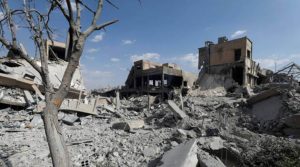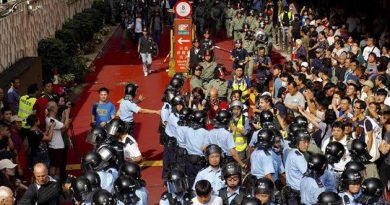US Struck Syria Without Certainty on Sarin

Even though US intelligence agencies did not have absolute certainty Syria’s regime had used the nerve agent sarin against civilians, the Trump administration still felt there was enough evidence to justify retaliatory strikes last Friday, several intelligence and defense officials tell CNN.
The decision to proceed with military action met a standard of evidence needed that officials felt they could accept, these sources said.
Officials are adamant that whatever was used by Syrian President Bashar al-Assad’s forces to attack civilians was a chemical agent and that alone justified taking action.
Trump’s acceptance of a military option to conduct missile strikes against three suspected Syrian chemical research, development and storage sites was shaped by the Pentagon’s classified intelligence assessment.
Video assessed by US intelligence after the Syrian regime’s attack and witness statements provide substantial evidence that victims most likely suffered the effects of an attack with chlorine and a nerve agent that was likely sarin, the officials said.
The US had consistently looked for intelligence from three areas: samples of the chemical used, possible electronic intercepts of Syrian officials involved in the attack or electronic intelligence on aircraft flying at the time of the attack.
Even at a late-night news conference just hours after the strike, Mattis said that while he was “absolutely confident” the Syrian regime had conducted a chemical attack, he was publicly less certain about what was used.
“We are very much aware of one of the agents. There may have been more than one agent used. We are not clear on that yet. We know at least one chemical agent was used,” said Mattis. The secretary went on to say that “we’re very confident that chlorine was used. We are not ruling out sarin right now.”
A senior administration official expressed even more confidence the following day, telling reporters that “we assess that both sarin and chlorine were used in this attack, and while the available information is much greater on the chlorine use, we do have significant information that also points to sarin use.”
Still, that same day, Vice President Mike Pence held out on a final judgment about whether sarin gas was deployed in his remarks Saturday afternoon.
“Chlorine and possibly nerve agents were used,” Pence said during his address at the Summit of the Americas in Lima, Peru.
The Pentagon has provided no update on any testing of chemical samples, saying it’s still looking at the intelligence.
On Tuesday, State Department spokeswoman Heather Nauert echoed the senior administration official’s Saturday comments, saying, “We have information that leads us to believe that both chlorine and sarin were used in the attack.”
Concerns over Russia
The attack by Assad’s forces killed dozens of men, women and children and injured hundreds more in the eastern Damascus suburb of Douma on April 7.
In the immediate aftermath of the attack, the White House detailed the inventory that Assad still has left and could possibly use again.
“The United States also assesses the regime still has chemicals — specifically, sarin and chlorine — that it can use in future attacks and that the regime retains the expertise necessary to develop new weapons. The Syrian military also maintains a variety of chemical-capable munitions — including grenades, aerial bombs, and improvised munitions — that it can use with little to no warning,” the White House said in a statement Friday.
Unlike the US strike a year ago after Syrian jets struck civilians with nerve agent bombs, this time helicopters were used.
That meant that, unlike last year, the US did not readily have electronic intelligence showing the track of the helicopters, as it would with fixed-wing jets.
All these factors were part of the case made by the Pentagon to pick a list of targets different from those struck in the previous response attack, but also targets that did not risk Russian escalation. There was worry that the US did not have a full understanding of whether some locations of Syrian aircraft and helicopters included a Russian presence. In the days prior to the coalition strike, there was confirmed intelligence that the Syrians had moved some aircraft to different locations, the officials said.
This entire intelligence assessment formed the backbone of Friday’s White House statement, which said in part, “this conclusion is based on descriptions of the attack in multiple media sources, the reported symptoms experienced by victims, videos and images showing two assessed barrel bombs from the attack, and reliable information indicating coordination between Syrian military officials before the attack. A significant body of information points to the regime using chlorine in its bombardment of Duma, while some additional information points to the regime also using the nerve agent sarin.”
Officials said the assessment that the Syrian regime was behind the attack, with Russian complicity, was based on the intelligence conclusion that only the Syrian regime had the chemical inventory and the means to attack with barrel bombs from helicopters.
Courtesy : CNN
Photo : storiesflow.com
[social_warfare buttons=”Facebook,Pinterest,LinkedIn,Twitter,Total”]



